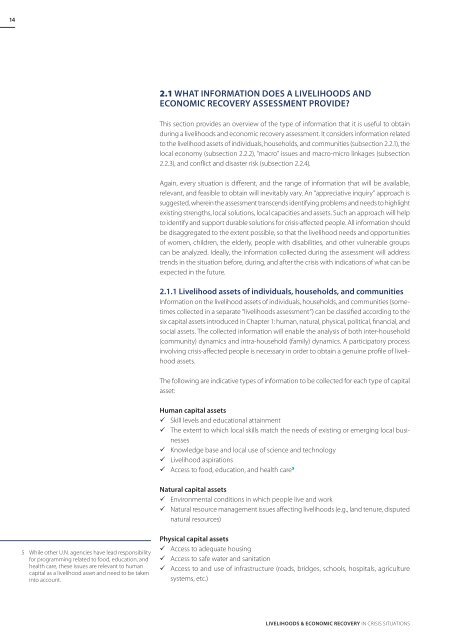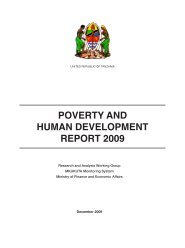Download PDF (4.08 MB) - ReliefWeb
Download PDF (4.08 MB) - ReliefWeb
Download PDF (4.08 MB) - ReliefWeb
Create successful ePaper yourself
Turn your PDF publications into a flip-book with our unique Google optimized e-Paper software.
14<br />
2.1 What information does a livelihoods and<br />
economic recovery assessment provide?<br />
This section provides an overview of the type of information that it is useful to obtain<br />
during a livelihoods and economic recovery assessment. It considers information related<br />
to the livelihood assets of individuals, households, and communities (subsection 2.2.1), the<br />
local economy (subsection 2.2.2), “macro” issues and macro-micro linkages (subsection<br />
2.2.3), and conflict and disaster risk (subsection 2.2.4).<br />
Again, every situation is different, and the range of information that will be available,<br />
relevant, and feasible to obtain will inevitably vary. An “appreciative inquiry” approach is<br />
suggested, wherein the assessment transcends identifying problems and needs to highlight<br />
existing strengths, local solutions, local capacities and assets. Such an approach will help<br />
to identify and support durable solutions for crisis-affected people. All information should<br />
be disaggregated to the extent possible, so that the livelihood needs and opportunities<br />
of women, children, the elderly, people with disabilities, and other vulnerable groups<br />
can be analyzed. Ideally, the information collected during the assessment will address<br />
trends in the situation before, during, and after the crisis with indications of what can be<br />
expected in the future.<br />
2.1.1 Livelihood assets of individuals, households, and communities<br />
Information on the livelihood assets of individuals, households, and communities (sometimes<br />
collected in a separate “livelihoods assessment”) can be classified according to the<br />
six capital assets introduced in Chapter 1: human, natural, physical, political, financial, and<br />
social assets. The collected information will enable the analysis of both inter-household<br />
(community) dynamics and intra-household (family) dynamics. A participatory process<br />
involving crisis-affected people is necessary in order to obtain a genuine profile of livelihood<br />
assets.<br />
The following are indicative types of information to be collected for each type of capital<br />
asset:<br />
Human capital assets<br />
Skill levels and educational attainment<br />
The extent to which local skills match the needs of existing or emerging local businesses<br />
Knowledge base and local use of science and technology<br />
Livelihood aspirations<br />
Access to food, education, and health care 5<br />
Natural capital assets<br />
Environmental conditions in which people live and work<br />
Natural resource management issues affecting livelihoods (e.g., land tenure, disputed<br />
natural resources)<br />
5 While other U.N. agencies have lead responsibility<br />
for programming related to food, education, and<br />
health care, these issues are relevant to human<br />
capital as a livelihood asset and need to be taken<br />
into account.<br />
Physical capital assets<br />
Access to adequate housing<br />
Access to safe water and sanitation<br />
Access to and use of infrastructure (roads, bridges, schools, hospitals, agriculture<br />
systems, etc.)<br />
Livelihoods & Economic Recovery in Crisis Situations





